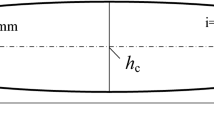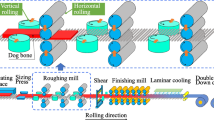Abstract
Flatness prediction is a critical technical concern in flatness feedforward control during strip cold rolling. This work realized a high-precision prediction of flatness for strip cold rolling by the data-driven and industrial Internet of Things (IIoT) technology and provided an effective mode for industrial data utilization. A flatness prediction model based on general regression neural network (GRNN) optimized by the differential evolutionary (DE) algorithm was proposed; an intact dataset was established by collecting data from the hot rolling and cold rolling production lines by develo** a cross-process IIoT platform, and the proposed model and other common data-driven models are trained and tested based on that. The experiment results obtained based on a dataset with 50,000 samples show that the proposed model is feasible and can achieve accurate prediction of flatness during the strip cold rolling, and compared with the BP and SVM model, it has a better performance.












Similar content being viewed by others
Data availability
The authors confirm that the data and material supporting the findings of this work are available within the article.
Code availability
Not applicable.
References
Li XG, Fang YM, Liu L (2020) Kernel extreme learning machine for flatness pattern recognition in cold rolling mill based on particle swarm optimization. J Braz Soc Mech Sci Eng 42:270. https://doi.org/10.1007/s40430-020-02357-8
Ma XB, Wang DC, Liu HM (2017) Coupling mechanism of control on strip profile and flatness in single stand universal crown reversible rolling mill. Steel Res Int 88(9). https://doi.org/10.1002/srin.201600495
Tran DC, Tardif N, Limam A (2015) Experimental and numerical modeling of flatness defects in strip cold rolling. Int J Solids Struct 69–70:343–349. https://doi.org/10.1016/j.ijsolstr.2015.05.017
Zhang SH, Deng L, Tian WH, Che LZ, Li Y (2022) Deduction of a quadratic velocity field and its application to rolling force of extra-thick plate. Comput Math Appl 109:58–73. https://doi.org/10.1016/j.camwa.2022.01.024
Wang P, Wang H, Li X, Zhang D, Yao Y (2021) A double-layer optimization model for flatness control of cold rolled strip. Appl Math Model 91:863–874. https://doi.org/10.1016/j.apm.2020.09.028
Abdelkhalek S, Montmitonnet P, Potier-Ferry M, Zahrouni H, Legrand N, Buessler P (2010) Strip flatness modelling including buckling phenomena during thin strip cold rolling. Ironmaking Steelmaking 37(4):290–297. https://doi.org/10.1179/030192310X12646889255708
Liu HM, Shan XY, Jia CY (2013) Theory-intelligent dynamic matrix model of flatness control for cold rolled strips. J Iron Steel Res Int 20(8):01–07. https://doi.org/10.1016/S1006-706X(13)60133-8
Wang CT, Yang Q, Peng P, Sun WQ (2009) Dynamic shape control strategy for wide strip tandem cold mills. J Univ Sci Technol Bei**g 31(04):492–498
Li LJ, **e HB, Liu TW, Huo MS, Liu X, Li XS, Shi KX, Li JX, Liu HQ, Sun L, Jiang ZY (2022) Influence mechanism of rolling force on strip shape during tandem hot rolling using a novel 3D multi-stand coupled thermo-mechanical FE model. J Manuf Process 81:505–521. https://doi.org/10.1016/j.jmapro.2022.07.025
Li LJ, **e HB, Zhang T, Pan D, Li XS, Chen FH, Liu TW, Liu X, Liu HQ, Sun L, Jiang ZY (2022) Influence of intermediate roll shifting on strip shape in a CVC-6 tandem cold mill based on a 3D multi-stand FE model. Int J Adv Manuf Technol 121:4367–4385. https://doi.org/10.1007/s00170-022-09529-x
Zhang SH, Deng L, Che LZ (2022) An integrated model of rolling force for extra-thick plate by combining theoretical model and neural network model. J Manuf Process 75:100–109. https://doi.org/10.1016/j.jmapro.2021.12.063
Zhang SH, Che LZ, Liu XY (2021) Modelling of deformation resistance with big data and its application in the prediction of rolling force of thick plate[J]. Math Probl in Eng 2021:1–10. https://doi.org/10.1155/2021/2500636
He F, Zhang LY (2018) Mold breakout prediction in slab continuous casting based on combined method of GA-BP neural network and logic rules. Int J Adv Manuf Technol 95:4081–4089. https://doi.org/10.1007/s00170-017-1517-1
Wang ZH, Gong DY, Li X, Li GT, Zhang DH (2017) Prediction of bending force in the hot strip rolling process using artificial neural network and genetic algorithm (ANN-GA). Int J Adv Manuf Technol 93:3325–3338. https://doi.org/10.1007/s00170-017-0711-5
Song LB, Xu D, Wang XC, Yang Q, Ji YF (2022) Application of machine learning to predict and diagnose for hot-rolled strip crown. Int J Adv Manuf Technol 120:881–890. https://doi.org/10.1007/s00170-022-08825-w
Qin AK, Huang VL, Suganthan PN (2009) Differential evolution algorithm with strategy adaptation for global numerical optimization. IEEE T Evolut Comput 13(2):398–417. https://doi.org/10.1109/TEVC.2008.927706
Deng W, Shang SF, Cai X, Zhao HM, Song YJ, Xu JJ (2021) An improved differential evolution algorithm and its application in optimization problem. Soft Comput 25:5277–5298. https://doi.org/10.1007/s00500-020-05527-x
Specht DF (1991) A general regression neural network. IEEE T Neural Networ 2(6):568–576
Wang QL, Sun J, Li X, Liu YM, Wang PF, Zhang DH (2018) Numerical and experimental analysis of strip cross-directional control and flatness prediction for UCM cold rolling mill. J Manuf Process 34:637–649. https://doi.org/10.1016/j.jmapro.2018.07.008
Wang QL, Sun J, Li X, Wang ZH, Wang PF, Zhang DH (2020) Analysis of lateral metal flow-induced flatness deviations of rolled steel strip: mathematical modeling and simulation experiments. Appl Math Model 77:289–308. https://doi.org/10.1016/j.apm.2019.07.036
Sun J, Deng JF, Peng W, Zhang DH (2021) Strip crown prediction in hot rolling process using random forest. Int J Precis Eng Manuf 22:301–311. https://doi.org/10.1007/s12541-020-00454-1
Zhang XL, Cheng L, Hao S, Gao WY, Lai YJ (2016) The new method of flatness pattern recognition based on GA–RBF–ARX and comparative research. Nonlinear Dyn 83:1535–1548. https://doi.org/10.1007/s11071-015-2428-z
Zhang XL, Zhao L, Zang JY, Fan HM (2015) Visualization of flatness pattern recognition based on T-S cloud inference network. J Cent South Univ 22:560–566. https://doi.org/10.1007/s11771-015-2556-0
Xue A, Yang WL, Yuan XM, Yu BP, Pan CF (2022) Estimating state of health of lithium-ion batteries based on generalized regression neural network and quantum genetic algorithm. Appl Soft Comput 130. https://doi.org/10.1016/j.asoc.2022.109688
Jiang P, Chen JJ (2016) Displacement prediction of landslide based on generalized regression neural networks with K-fold cross-validation. Neurocomputing 198:40–47. https://doi.org/10.1016/j.neucom.2015.08.118
Martínez F, Charte F, Frías MP, Martínez-Rodríguez AM (2022) Strategies for time series forecasting with generalized regression neural networks. Neurocomputing 491:509–521. https://doi.org/10.1016/j.neucom.2021.12.028
Rakhshani H, Idoumghar L, Lepagnot J, Brevilliers M (2019) Speed up differential evolution for computationally expensive protein structure prediction problems. Swarm Evol Comput 50:100493. https://doi.org/10.1016/j.swevo.2019.01.009
Peng L, Liu S, Liu R, Wang L (2018) Effective long short-term memory with differential evolution algorithm for electricity price prediction. Energy 162:1301–1314. https://doi.org/10.1016/j.energy.2018.05.052
Mezura-Montes E, Coello CAC (2008) An empirical study about the usefulness of evolution strategies to solve constrained optimization problems. Int J Gen Syst 37(4):443–473
Kumar J, Singh AK (2018) Workload prediction in cloud using artificial neural network and adaptive differential evolution. Future Gener Comp Sy 81:41–52. https://doi.org/10.1016/j.future.2017.10.047
Polat O, Yildirim T (2008) Genetic optimization of GRNN for pattern recognition without feature extraction. Expert Sys Appl 34(4):2444–2448
Qiao L, Liu Y, Zhu JC (2020) Application of generalized regression neural network optimized by fruit fly optimization algorithm for fracture toughness in a pearlitic steel. Eng Fract Mechanics 235(s3):107105. https://doi.org/10.1016/j.engfracmech.2020.107105
Ji YF, Song LB, Sun J, Peng W, Li HY, Ma LF (2021) Application of SVM and PCA-CS algorithms for prediction of strip crown in hot strip rolling. J Cent South Univ 28(8):2333–2344. https://doi.org/10.1007/s11771-021-4773-z
Funding
The work would like to thank the China Postdoctoral Science Foundation (Grant No. 2021M690352) for their financial support.
Author information
Authors and Affiliations
Contributions
Jianwei Zhao: conceptualization; writing—review and editing; funding acquisition. **gdong Li: methodology; writing—original draft. Haotang Qie: resources, software. **aochen Wang: formal analysis, conceptualization. Jian Shao: formal analysis, methodology. Quan Yang: project administration, supervision.
Corresponding author
Ethics declarations
Ethics approval
Not applicable.
Consent to participate
Not applicable.
Consent for publication
This work is approved by all authors for publication.
Competing interests
The authors declare no competing interests.
Additional information
Publisher's note
Springer Nature remains neutral with regard to jurisdictional claims in published maps and institutional affiliations.
Rights and permissions
Springer Nature or its licensor (e.g. a society or other partner) holds exclusive rights to this article under a publishing agreement with the author(s) or other rightsholder(s); author self-archiving of the accepted manuscript version of this article is solely governed by the terms of such publishing agreement and applicable law.
About this article
Cite this article
Zhao, J., Li, J., Qie, H. et al. Predicting flatness of strip tandem cold rolling using a general regression neural network optimized by differential evolution algorithm. Int J Adv Manuf Technol 126, 3219–3233 (2023). https://doi.org/10.1007/s00170-023-11330-3
Received:
Accepted:
Published:
Issue Date:
DOI: https://doi.org/10.1007/s00170-023-11330-3




